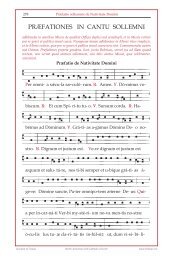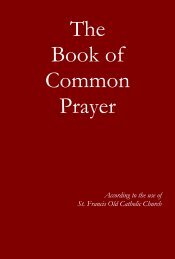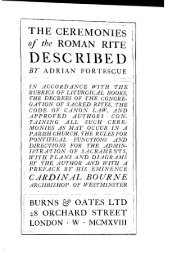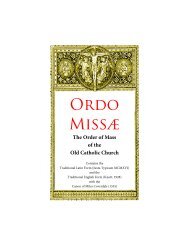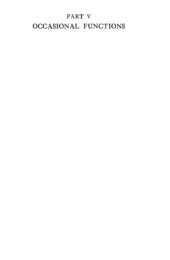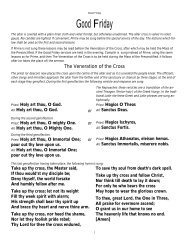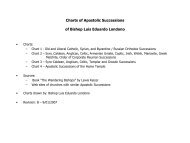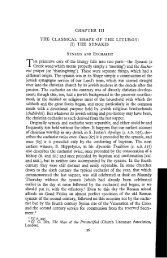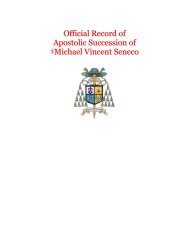Eucharist and Lord's Supper
Eucharist and Lord's Supper
Eucharist and Lord's Supper
Create successful ePaper yourself
Turn your PDF publications into a flip-book with our unique Google optimized e-Paper software.
EUCHARIST AND LORD'S SUPPER<br />
93<br />
almost open indication that its author has in mind something other than<br />
:he eU~harist proper. He writes of his blessed cup <strong>and</strong> bread, 'For concernmg<br />
thIs ~!so the Lord, s3id, "Give not that which is holy unto the dogs" ,<br />
(Matt.. V:l. 6). The blessed bread' of the agape is holy, though not<br />
euchanstIc.<br />
We conclude, then, that Didache ix. <strong>and</strong> x. are entirely in line with what<br />
we know of the Eastern agape in pre-Nicene times, as Didache xiv. is entirely<br />
representative of second century ideas about the liturgical eucharist.<br />
The book was written as a guide for the laity, not for the clergy, <strong>and</strong><br />
elsewhere gives detailed regulations only on things which the laity may do<br />
for themselves. These little agape prayers may be taken as the exact Eastern<br />
equivalents ofHippolytus' general direction to the laity when met without<br />
a cleric at the <strong>Lord's</strong> supper to 'eucharistise' the food each one for himself,<br />
<strong>and</strong> then 'eat in the Name of the Lord'. Prophets, as specially inspired<br />
persons, even though laymen, are not bound to use the set forms; just as<br />
the bishop, in virtue of his prophetic charisma, is not bound to follow a set<br />
form in the eucharistic prayer proper.<br />
This is the agape or <strong>Lord's</strong> supper as celebrated privately by a party of<br />
christian friends. But in the third century in the East it could still be a<br />
corporate <strong>and</strong> official observance of the whole church. In a Syrian work<br />
written c. A.D. 250, the Didascalia Apostolorum, the author, speaking of the<br />
reception to be accorded to christian strangers visiting another church,<br />
lays it down that 'Ifit be a bishop, let him sit with the bishop; <strong>and</strong> let him<br />
accord him the honour of his rank, even as himself. And do thou, 0<br />
bishop, invite him to discourse to thy people; for the exhortation <strong>and</strong><br />
admonition of strangers is very profitable, especially as it is written:<br />
"There is no prophet that is acceptable in his own place." And when you<br />
offer the oblation, let him speak. But if he is wise <strong>and</strong> gives the honour<br />
[i.e. of celebrating the eucharist] to thee, at least let him speak over the<br />
CUp'.1 Here we have evidence of the feeling that the bishop is the only<br />
proper prophetic teacher <strong>and</strong> priest of his own church, who ought not in<br />
any circumstances to be replaced at the eucharist by anyone else, however<br />
distinguished, when he is present. It witnesses also to the bishop's 'discourse'<br />
or exhortation at the agape, of which Hippolytus speaks. And it<br />
mentions the use of a cup in the East as an important element in that rite,<br />
just as in the Ethiopic order (c)<strong>and</strong> in the Didache (ix. 2).<br />
The last text of any importance or interest on the <strong>Lord's</strong> supper or<br />
agape which we need consider comes from an Egyptian rule for virgins<br />
leading an ascetic life in their own homes, in the days before the religious<br />
life for women in convents had been fully organised. It is traditionally<br />
ascribed to S. Athanasius, an attribution which has been both questioned<br />
<strong>and</strong> defended by modern scholars without decisive reasons on either side.<br />
But it appears to be Egyptian <strong>and</strong> of the early fourth century. It runs thus:<br />
1 Did. Ap., ii. 58. Ed. R. H. Connolly, 1929, p. 122.



